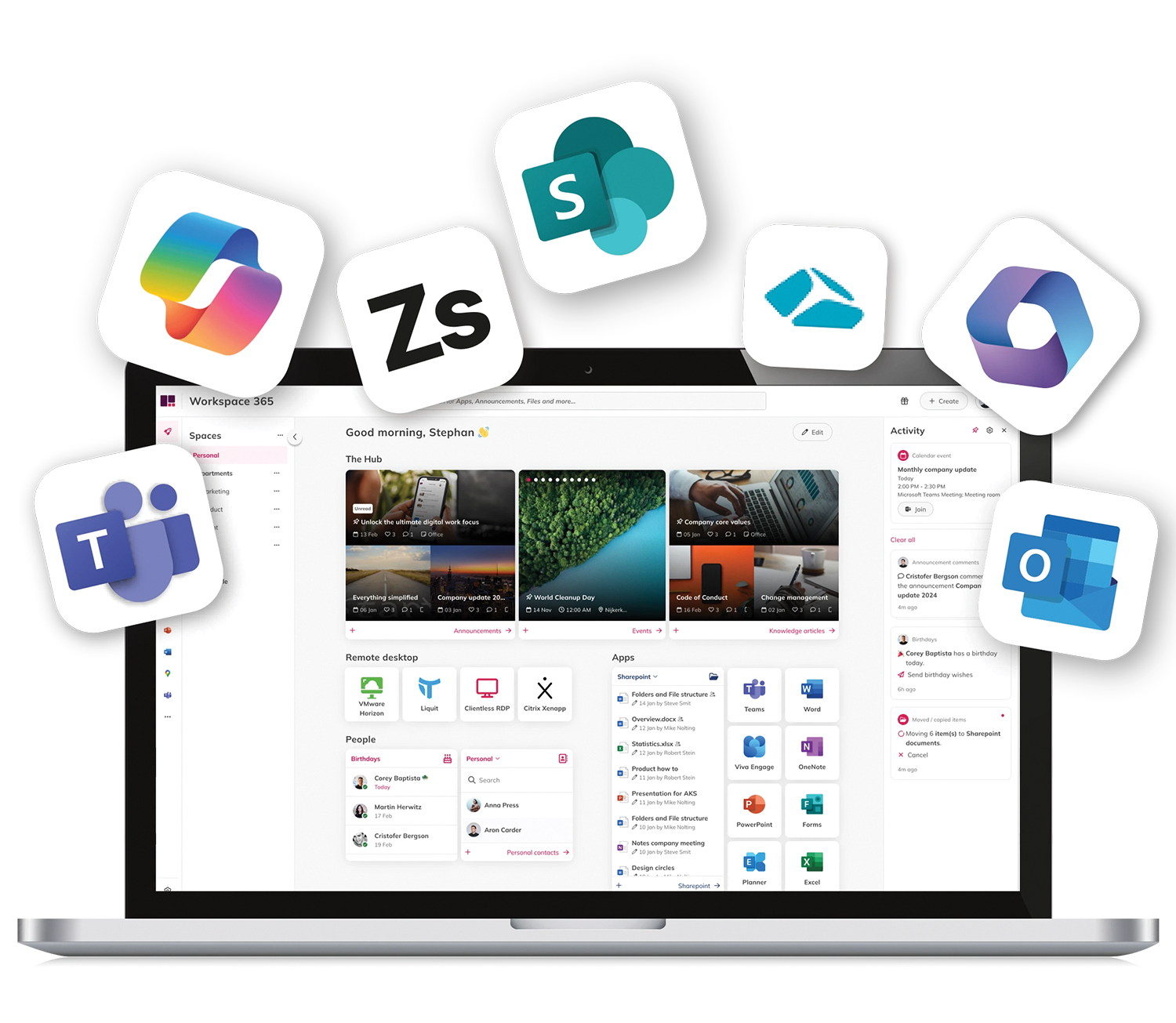Working remotely offers many advantages for both an organisation and its employees. Many people are now required to work from home. This has accelerated the work from home culture. Gartner research shows that 88% of organisations have encouraged their employees to work from home during the COVID-19 crisis. Organisations urgently had to facilitate working from home, for example by working with a digital workspace. And now that offices are slowly reopening, more and more people are choosing to work from home (a few days a week) by default.
9 tips for increasing the engagement of remote employees
Clear agreements, clear goals and all the tools for an ultimate home office: is that not enough to successfully work remotely? It does indeed get you a long way, but a clear focus on employee engagement remains essential.
The employee engagement is directly linked to the business results. In organisations where employees are highly engaged, employees are 57% more effective and 87% less likely to leave. You can achieve this engagement by providing all employees with a good experience; remote or not. MIT research found that companies that scored within the top quartile in providing a good employee experience achieved double the innovation, double the customer satisfaction, and 25% higher profits than the organisations that ranked in the lowest quartile. Employee engagement is therefore clearly important for your organisation.
This brings us to the challenge of keeping the employees engaged that you don’t or barely see (in real life): how do you do it?
1. Keep a dialogue going
Many people underestimate how often you communicate with people on your team in the office outside the work meetings: how they are doing, how they’re feeling and what challenges they encounter. These kinds of conversations are just as important with remote employees. Unfortunately, they are often forgotten, because the contact moments are scheduled around work meetings. That is why, for these employees, it can feel like you are not interested in their well-being. Therefore, take the time to ask them about their circumstances and mood at every contact moment. Listen to what they say, and if things are not going well, try to figure out what to do about it together.
2. Make maximum use of video
People often choose to ‘quickly make a call’, while video calling is just as easy. And this is the preferred option, seen as it has a lot of added value for the conversation and the bond between you and your remote employee. During a normal phone call, a lot of valuable communication gets lots, such as body language, facial expressions and gestures. This non-verbal communication does not only make the conversation easier and clearer for everyone to follow and understand, but also ensures that a person is more than just a voice, building stronger relationships and a greater sense of trust.
3. Build trust
It is often thought that for remote work there must be trust, particularly of management in their employee; that he or she is actually doing their job. Although this is indeed important, trust also goes the other way. The remote employee also has to have trust in management: that they can turn to this person(s), that they are provided with the tools and support they need, and that they receive as much attention as the people who management does see every day in the office. You build this trust by, among other things, the aforementioned moments of communication, by maintaining a relationship with the remote employee, but also by paying and keeping attention to their career path.
4. Keep paying attention to the career path
Just because someone works in a different place, doesn’t mean they want to stay in the same place – career-wise, at least. Because a person performs his or her work less visibly than someone you can see doing their work in person, it is sometimes overlooked that this person is working towards something. Remote employees are just as likely to want to take steps in their careers as the people in the office. It is therefore essential to pay attention to this and to offer remote employees the same growth opportunities as non-remote employees. You can do this, for example, by establishing a growth path together, in which you document learning and growth moments. By regularly scheduling a moment to discuss this growth path, you maintain focus on the personal and professional growth of the remote employee and ensure that they get the same opportunities as office employees.
5. Strengthen your core values
You can put your core values on the walls throughout the office, but core values really need to be felt by people – and this is all the more important for remote workers. So don’t just communicate your core values, but act accordingly. If giving people the opportunity to grow is very important to your organisation, make sure people actually get those opportunities – remote or not. The same applies to transparency, flexibility, loyalty or any other core value that you can have as an organisation: put your words into action. For example, if team spirit forms the foundation of your organisation, make sure that people can build that team spirit.
6. Create opportunities for social interaction
Just because you’re not physically there, doesn’t mean you can’t have a good time with colleagues. The so-called “watercooler conversations” (or at Workspace 365, the coffee machine conversations) contribute largely to the working atmosphere, as well as company drinks and outings. Therefore, go a step further than the Friday afternoon drinks at the office to involve your remote employees. Think of virtual drinks, social video calls or online pub quizzes. A positive social connection is good for the atmosphere in the team, and that way the team also gets to know each other outside of work.
7. Extra focus on acknowledgement
A compliment for a job well done is motivating. After all, you have worked hard and it is nice that this is acknowledged. This acknowledgement is given extra value when it is voiced in front of colleagues. This happens regularly at the office: during meetings, during lunch or simply on the work floor. It is easier to publicly acknowledge someone in a physical location. Therefore, look for ways to achieve the same effect for your remote employees. Think of moments of acknowledgement during online meetings, but also on your business social media.
8. Let everyone celebrate successes
Sometimes, rewards can pass remote employees by. Such as when people toast an achieved goal in the office, or a dinner is organised after a successful month. Purely because of his or her location, a remote employee often falls by the wayside here. Therefore, make sure you have an alternative for these employees, so that they feel involved as well. After all, they have also been a part of whatever it is that you’re celebrating. Do you have a champaign toast at the office? Send your remote employees a bottle of champagne as well. Are you going out to dinner with the team? Let them experience that too with a dinner voucher. There are dozens of things to think of, from sending flowers to having a nice lunch delivered, with which you let your remote employees celebrate their successes too.
9. Invest in company goodies
There’s a reason companies invest in thousands upon thousands of pens, cups and other goods with their logo on it every year. And that one of the greatest things about an event is the goodie bag: because it works. Why would you only use this for external parties, and not internally? With fun goodies from your own brand, be it a mouse pad, sweater, bag or laptop sleeve, you can involve remote employees more in your company and let them become an ambassador for your brand. Some companies even take this to the next level by sending goodies to the entire family.
Manage your remote employees in the digital workspace
By using a digital workspace, you are already well on your way to having employees work remotely successfully. For example, with an adaptive workspace they have access to everything they need to work, from applications to information, anytime, anywhere. In addition, they can easily collaborate remotely with their colleagues, for example by simultaneously working together on documents.
But as we mentioned at the beginning of this blog, the right technology is only part of successful remote work. However, you can use this technology to enhance these other components, such as social interaction and culture.
Connect with communication tools and (enterprise) social media
Within Workspace 365, you can easily integrate your communication tools, such as Microsoft Teams and Yammer. While Teams is evidently of significance due to the possibilities it offers in the field of communication and video conferencing, Yammer can also play a major role in engaging remote employees.
For example, you can use Yammer to make remote employees feel more connected, by providing an additional interaction platform on which they can interact with colleagues with whom they do not necessarily collaborate directly, and thus are not likely to be in touch with otherwise. It is also a great place to publicly acknowledge remote employees for their achievements. With Yammer you can create a community and thus strengthen the corporate culture, also for remote employees.
Keep remote employees informed with Announcements
One of the most important ways to keep a remote employee engaged, is to keep him or her informed. It is difficult to feel engaged with something you hardly know anything about. The Announcements live tile is a great tool for this. It allows you to share company news with all employees. This does not only have to be important and “heavy” messages or household announcements. You can also think of fun facts, team achievements and inspiring messages from managers.
Integrate videos
A visual is much more effective at making people feel connected than written text. That is why you can also integrate videos in the adaptive workspace. For example, instead of an inspiring message from managers, you can also share an inspiring video recording, or videos of a company event.
Within Workspace 365, the integration possibilities are endless. This way, you choose your own tools and resources that fit perfectly with your organisation, culture and employees, so that you can maintain the relationship with your remote employees from a distance. Because although successful remote working is about more than technology, the right technology can support you in this.






